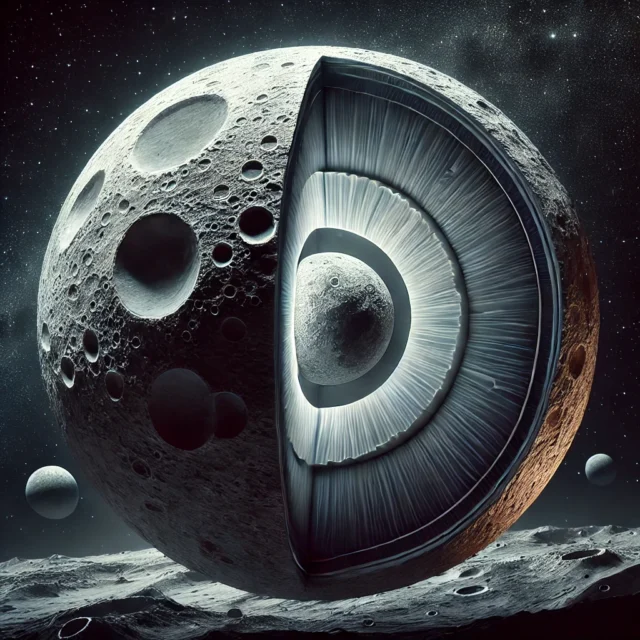Scientists have finally confirmed what lies at the heart of our Moon in a revelation that shatters long-standing myths. Spoiler alert: it’s not made of green cheese. Instead, a groundbreaking study published in May 2023 revealed that the Moon’s inner core is a solid sphere with a density strikingly similar to iron’s.
This discovery not only resolves a heated debate about the Moon’s internal structure but also opens new doors to understanding the history of our closest celestial neighbour—and, by extension, the early days of the Solar System.
Led by astronomer Arthur Briaud from the French National Centre for Scientific Research, the research team states, “Our findings challenge previous theories about the Moon’s magnetic field evolution by confirming the existence of a solid inner core. This supports a global mantle overturn model, providing valuable insights into the timeline of lunar impacts during the first billion years of the Solar System.”
Understanding the internal makeup of planetary bodies within our Solar System often hinges on seismic data. Scientists can create a detailed map of what lies beneath a planet or moon’s surface by studying how seismic waves—generated by quakes—travel through and reflect off different materials.

The Apollo missions provided us with invaluable lunar seismic data, but its resolution was too low to determine the state of the Moon’s core definitively. We knew a fluid outer core existed, but whether it encased a solid inner core or was entirely molten remained a mystery. Both scenarios seemed equally plausible based on the available data.
Briaud and his colleagues compiled data from various space missions and lunar laser-ranging experiments to crack this puzzle. These datasets included measurements of the Moon’s deformation due to Earth’s gravitational pull, variations in its distance from Earth, and its overall density.
An artist’s impression of different instruments used to measure the Moon’s properties and reveal its core structure. (Géoazur/Nicolas Sarter)
The team then ran simulations with different core models to see which best matched the observed data.
Several fascinating findings emerged. Notably, the most accurate models suggest active overturn deep within the lunar mantle—a process where denser material sinks toward the center while less dense material rises. This mechanism has long been proposed to explain certain elemental concentrations in the Moon’s volcanic regions, and the new research adds substantial weight to this theory.
Further, the study reveals that the Moon’s core resembles Earth’s, featuring a fluid outer layer and a solid inner core. According to the model, the outer core has a radius of approximately 362 kilometres (225 miles), while the inner core spans about 258 kilometres (160 miles)—about 15% of the Moon’s total radius.
The inner core’s density was about 7,822 kilograms per cubic meter, closely aligning with the density of iron.
Interestingly, a 2011 study led by NASA’s planetary scientist Renee Weber found similar results using advanced seismological techniques on Apollo data. Weber’s team detected evidence of a solid inner core with a radius of about 240 kilometers and a density near 8,000 kilograms per cubic meter.
Briaud’s team considers their findings a robust confirmation of these earlier results, presenting a compelling case for an Earth-like core structure within the Moon. This has significant implications for our understanding of the Moon’s evolution.
We know that not long after its formation, the Moon generated a powerful magnetic field, which began to decline around 3.2 billion years ago. This magnetic field would have been driven by movement and convection within the core, making the core’s composition a key factor in understanding why this magnetic field eventually disappeared.
With humanity’s return to the Moon on the horizon, it’s possible that we won’t have to wait long for further seismic data to confirm these groundbreaking findings.
The research is published in Nature.
This article was initially published in May 2023.









